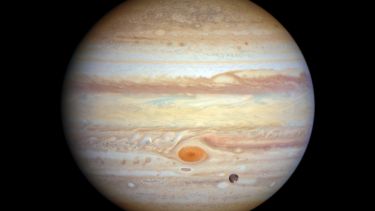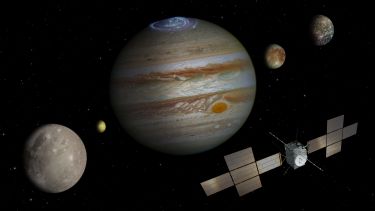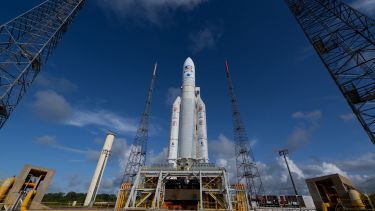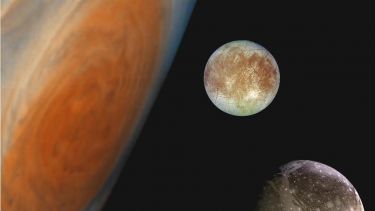- University of Sheffield academics are working with the European Space Agency on a mission to take detailed observations of Jupiter’s three icy moons
- Launching today (13 April 2023), Sheffield researchers have contributed to key scientific instruments onboard the spacecraft that marks a new chapter in the hunt for extraterrestrial life
A mission to search for signs of life on Jupiter and its three icy moons is set to launch today (13 April 2023) with help from researchers at the University of Sheffield.
The Jupiter Icy Moons Explorer - or Juice - will spend the next eight years on a voyage into deep space to take detailed observations of the giant gas planet and its three large ocean-bearing moons - Ganymede, Callisto and Europa.
The mission will open up a new chapter in the hunt for extraterrestrial life and will be the first spacecraft ever to orbit a moon other than our own - Jupiter’s largest moon Ganymede.
The team from the University of Sheffield has contributed to the development of the Radio and Plasma Wave Instrument (RPWI) - one of the key scientific instruments onboard the Juice spacecraft. It will measure electric and magnetic fields and characterise the radio emission and plasma environment of Jupiter and its moons.
As the quantity of data potentially observable is much greater than that which can be transmitted back to the Earth, Dr Keith Yearby from the University of Sheffield’s Department of Automatic Control and Systems Engineering has produced a data compression technique for the mission to send information back to Earth as compactly as possible within onboard data limits.
Dr Yearby, said: “The hunt for life on other planets is fascinating, so we're really excited to see what data the Juice mission captures and what it can tell us about Jupiter and its three icy moons.
"Data compression is commonly used in a vast range of modern technology applications here on Earth, but to use it onboard a spacecraft to transmit data to us from deep space is much more challenging. The Juice spacecraft will take eight years to reach Jupiter, so we need to ensure that once it arrives it is capable of transmitting this crucial data back to us without any gaps or errors.
"Being on a spacecraft means there is only limited onboard data processing available, so we had to design a bespoke technique that is tailored for optimum performance."
Professor Michael Balikhin and Dr Simon Pope from the University’s Department of Automatic Control and Systems Engineering will also carry out scientific research for the mission once the Juice spacecraft sends data back to Earth.
Professor Michael Balikhin, said: “The near space environment around Jupiter and its moons is composed of a plasma, an ionised gas made up of ions with a positive electric charge and negatively charged electrons.
“The plasma is extremely thin, so unlike in most normal gases, such as a planetary atmosphere, the particles do not collide. This means various waves and electromagnetic fields in the plasma and not particle collisions, play the pivotal role in important processes such as energy transfer.
“The data that will be sent back by the Radio and Plasma Wave Instrument will be very important to advance our knowledge about the processes that are taking place in the Jovian environment."
Dr Simon Pope, said: “Jupiter is a natural source of strong high frequency radio emissions. The instrument we have helped to create can take advantage of this radiation and operate as a passive ground penetrating radar to study the characteristics of the undersurface layers of Jupiter’s moons. The data it is set to gather is unprecedented and we hope it will give us a deeper understanding of Jupiter’s complex environment.”
The lead scientist for Juice’s Radio and Plasma Wave Instrument is Dr Jan-Erik Wahlund from Institute of Space Physics Sweden.
Juice is expected to launch from Europe’s Spaceport in French Guiana, South America on 13 April 2023. It is estimated that it will reach Jupiter and its moons by 2031.
More information on the mission.
Contact
For further information please contact:






